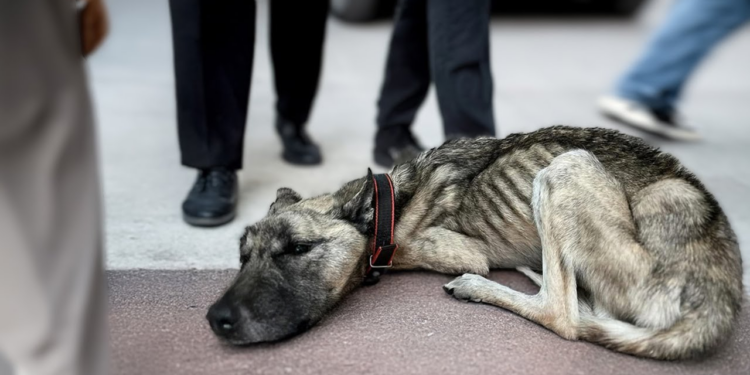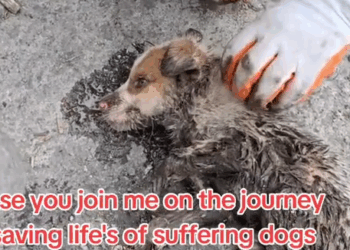The Struggles of a Malnourished Dog: A Heartbreaking Plea for Help
Every day, countless animals face unimaginable hardship, often without a voice to plead for their lives. Among these are the dogs that are abandoned, neglected, or simply left to fend for themselves on the unforgiving streets. One such heartbreaking story revolves around a malnourished dog, whose body bore the marks of desperation and survival. This dog, after days of scavenging garbage for sustenance, found itself begging passersby for help. The image of a starving animal, fighting to survive and pleading for mercy, is a tragic reminder of the unfortunate reality faced by many stray animals.
This dog’s ordeal began much like that of countless others. Abandoned by its owners or born into a world of cruelty and neglect, it had no choice but to turn to the streets for survival. With no access to proper food or care, the dog was forced to rummage through trash, seeking whatever scraps it could find. But as days turned into weeks, the dog’s health began to deteriorate. Its once vibrant coat grew thin and patchy, its ribs became visible, and its energy waned as it struggled to find enough food to stay alive.
The true extent of the dog’s suffering only became apparent when it began to beg for help. Despite the constant barrage of noise and activity on the streets, the dog seemed to understand that its only hope for survival lay in the hands of strangers. With its sunken eyes filled with fear and desperation, it approached passerby after passerby, hoping someone would notice its plight and offer a helping hand. Unfortunately, the streets are often indifferent, and many people merely passed by, unable or unwilling to stop and assist.
Survival on the Streets: A Life of Scavenging
Surviving on the streets is a brutal existence for any animal, especially a dog. Without access to regular meals or proper medical care, street dogs often rely on whatever food they can find, often resorting to rummaging through garbage bins or begging for scraps. For this malnourished dog, this meant days of eating trash to stave off hunger. The food found in garbage bins is typically spoiled, contaminated, or completely inedible. Even when the dog managed to find something that could serve as sustenance, it was rarely enough to sustain it for long.
The body of a malnourished dog suffers greatly from prolonged periods without proper nutrition. Its immune system weakens, making it vulnerable to disease and infection. The dog may begin to lose weight rapidly, its fur becoming dull and patchy, and its energy levels decreasing as it is unable to sustain the activity required to find food. Each day, the dog becomes weaker and more desperate for help, and yet, it continues to fight for survival, not knowing if it will ever receive the care it so desperately needs.
But for this particular dog, the struggle for survival took a different turn when it began to beg passersby for help. Whether from hunger or an instinctual understanding of its need for help, the dog began to approach people, its eyes pleading for someone to notice its plight. The dog’s cries were not loud or frantic but quiet and desperate, as if it had already learned that loud begging would not always attract attention. Instead, it looked up at the faces of those who passed by, hoping for even the smallest gesture of kindness.
The Moment of Desperation: A Cry for Mercy
There are moments in life when we encounter suffering so profound that it stops us in our tracks. For the people who passed by this dog, many were unaware of the intense pain and desperation it was experiencing. Some may have seen the dog and averted their eyes, uncomfortable with the raw vulnerability it displayed. Others, perhaps caught in their own rush, did not stop to consider the dog’s distress. But for a few kind-hearted souls, the moment of desperation sparked a sense of compassion.
As the dog approached strangers, its body trembling from malnutrition and fear, the cries for help became more pronounced. The dog was no longer simply looking for food; it was searching for salvation. With each tearful glance, the dog was pleading for someone to rescue it from its pain and suffering. This was no longer just a matter of survival. The dog needed love, attention, and, most importantly, a chance for a better life.
Unfortunately, not every passerby noticed the dog’s cries, and the harsh reality of street life meant that the dog’s struggle for survival would continue unless someone intervened. But the story of this dog serves as a stark reminder of how many animals find themselves in these dire situations and how they rely on human kindness for survival.
The Cycle of Abandonment: Understanding the Root Cause

The situation faced by this malnourished dog is not an isolated case. Every year, millions of dogs are abandoned by their owners, left to roam the streets and fend for themselves. Whether due to economic hardship, ignorance, or sheer neglect, countless animals are left behind, often with no chance of survival. For those who survive, life on the streets is a constant battle against hunger, disease, and the elements.
This abandonment is often a result of irresponsible pet ownership. People may adopt pets without understanding the long-term commitment required to care for them, or they may decide they no longer want a pet when it becomes too much of a responsibility. In some cases, pets are abandoned because they are seen as disposable, as objects that can be cast aside when they are no longer convenient or desired. This mindset contributes to the overwhelming number of stray animals and the suffering they endure.
But abandonment is not only a societal issue—it is a moral one. Dogs, like all animals, deserve to be treated with respect, compassion, and care. When we abandon animals, we are failing them as caretakers, leaving them to suffer alone in a world that is often indifferent to their needs. This behavior leads to the cycle of abandonment, with countless animals left to fend for themselves, often suffering in silence.
The Role of Animal Shelters and Rescue Organizations
Fortunately, not all stories of abandoned dogs end in tragedy. Around the world, animal shelters and rescue organizations work tirelessly to rescue animals from situations of neglect and abuse. These organizations are staffed by dedicated individuals who are passionate about saving lives and offering animals a second chance at happiness.
When a dog like the one in this story is found, animal rescue organizations are often the first to respond. Their staff assesses the animal’s condition, provides immediate medical care, and ensures that the dog is placed in a safe, loving environment. In many cases, the dog is then placed with a foster family where it can receive the nurturing care it needs to recover from its trauma and regain its health.
In addition to providing medical care and shelter, these organizations work to rehabilitate animals, helping them overcome the emotional and psychological damage caused by abandonment. Dogs that have suffered on the streets often need extensive training and socialization before they can be adopted into a forever home. However, the patience and compassion provided by these organizations give these animals the chance to heal and thrive once again.
Furthermore, animal shelters and rescue organizations play an essential role in raising awareness about the issue of abandonment. They advocate for responsible pet ownership, promote adoption, and push for stronger laws to protect animals from cruelty and neglect. Through education and outreach, they hope to reduce the number of animals left to suffer on the streets.
Adoption: A Lifeline for Stray Animals
The ultimate goal of animal shelters and rescue organizations is to find loving, permanent homes for the animals in their care. For a dog like the one in this story, adoption represents a fresh start, a new beginning in a safe, nurturing environment. But adopting a dog is not just about offering a home—it is about committing to a lifelong responsibility.
Adoption is a powerful act of kindness, one that gives a dog the opportunity to experience love, care, and comfort after years of neglect. It is also a commitment to providing the dog with proper medical care, nutrition, training, and companionship for the rest of its life. Adopting a dog who has been abandoned is an act of compassion that can change both the animal’s life and the adopter’s life in profound ways.
Before adopting a dog, it is essential to consider the responsibilities that come with pet ownership. Dogs need daily care, attention, and training, and adopting a dog is a commitment that should not be taken lightly. However, for those who are ready to provide a loving home, adoption can be an incredibly rewarding experience.
Conclusion: The Importance of Compassion and Responsibility
The story of the malnourished dog begging for help is a tragic reflection of the suffering many stray animals endure. It serves as a powerful reminder of the importance of responsible pet ownership and the impact our actions—or inactions—can have on the lives of animals. Abandonment and neglect are not just acts of cruelty; they are failures to recognize the inherent value of animal life.
As a society, we must strive to do better. We must promote responsible pet ownership, advocate for stronger protections for animals, and support rescue organizations working tirelessly to provide care for abandoned animals. Most importantly, we must never forget the power of compassion. A simple act of kindness—whether it is rescuing a dog from the streets, providing food, or adopting a pet in need—can make all the difference in the life of an animal.
Every animal, regardless of its past, deserves a chance at a better life. It is our responsibility to give them that chance.
First battery-electric version of popular mid-size luxury SUV is on the way
Development of the first battery-electric version of the Mercedes-Benz GLC is entering the final stretch and new intel obtained by carsales indicates it will make its global debut earlier than expected in 2025.
Originally thought to be a late-decade proposition, the all-electric mid-size luxury SUV now looks set to break cover next year in a bid to reinvigorate EV sales for the German premium brand.
First launched in Europe in mid-2022 and released Down Under in mid-2023 (and since joined by the Coupe body style and both 43 and 63 AMG versions), the second-generation GLC is Mercedes-Benz’s best-selling model both globally and in Australia so far this year, having overtaken the C-Class mid-size sedan and GLE large SUV – but not rivals like the Tesla Model Y and Lexus NX.
But as production of the similarly-sized EQC dedicated electric SUV comes to a close, Mercedes-Benz is gearing up for what’s set to be one of its biggest new model launches in decades.



Details of the new pure-electric sister model to the GLC 300 are thin on the ground, but spy photos of the crucial new EV have been snapped in Europe – including what are believed to be high-performance AMG versions.
At this stage it’s unclear whether the first GLC EV will be based on the same MRA2 platform as the existing mid-size SUV or the German car-maker’s new MB.EA Medium platform – or even the petrol/electric Mercedes Modular Architecture (MMA) that will underpin the next-generation CLA, GLA and GLB.
But either of the latter two platforms would bring several advanced EV-specific features that were lacking in the EQC, such as bi-directional charging with V2L (vehicle to load) V2H (vehicle-to-home) functionality, not to mention faster recharging capability via an 800V electrical architecture.
Based on the same original MRA platform as the first-generation GLC, the EQC was never sold in the US, but the Mercedes-Benz GLC EV is understood to be heading Stateside, significantly increasing its global sales potential.
So it’s now looking likely Mercedes-Benz will simply revert to common designs and nameplates for EV versions of models like the C-Class, GLC-Class, E-Class and S-Class, with unique variant monikers to delineate their EV underpinnings.
The German car-maker’s EQ electric brand has struggled to capture the imagination of customers in significant numbers and its polarising EV designs are currently being reworked, as evidenced by the conservative new 2024 Mercedes-Benz EQS.

As EV sales level out globally, including in Australia, car-makers are increasingly back-pedalling on promises to switch to all-electric product portfolios, with Ford and Fiat being the latest to capitulate.
Mercedes-Benz has also hit the brakes on its electrification targets, which originally included a 50:50 sales split between petrol and electrified vehicles by 2025. Right now, only 11 per cent of all Mercedes-Benz sales globally are EVs, increasing to almost 20 per cent when hybrids are included.
A report from leading German business newspaper Handelsblatt recently also claimed that Mercedes-Benz has completely killed off the next-gen large vehicle platform that would have underpinned next-gen EQE and EQS models, suggesting that dedicated EVs and their EQ nameplates are both being quietly retired.





































